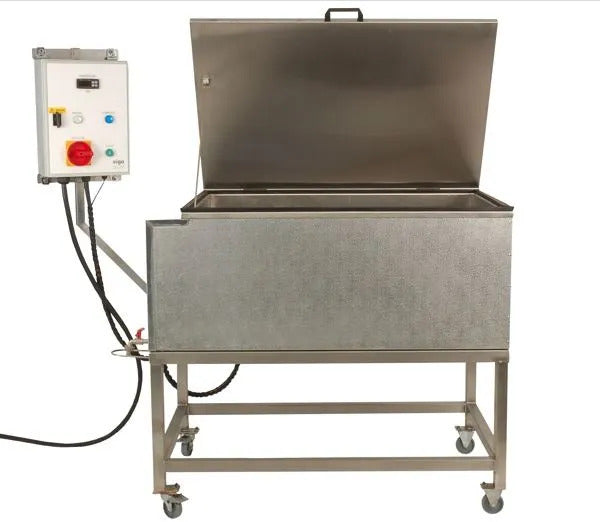Vigo in bottle pasteuriser
Vigo in bottle pasteuriser
Millions of bottles of premium apple juice are made each year using our in bottle pasteurisers.
- The bath of the pasteuriser holds 100 x 750ml bottles
- Between 500 and 800 bottles a day can be pasteurised, depending on operator and type of product
- Easy to operate control panel
- Tight temperature control
- Integrated time and temperature controller
- Audible and visible alarm
- Insulated tank and lid
- Manual fill into tank
- Draining tap
- Two or more pasteurisers can be used at the same time to increase pasteurisation rates
- Available as either single phase or 3 phase
NB: The trolley shown in photo is not included but available separately - see Trolley for Vigo In-bottle Pasteuriser
NB The single phase version will require hard-wiring (on-site) to an isolator by a suitably qualified electrician, therefore it is not supplied with a plug.
Additional Bottle Baskets are available to enable you to increase the pasteurisation hroughput of your pasteuriser.
We've supplied hundreds of these in-bottle pasteurisers over the years. A small sample of which are featured in our customer Case Studies.
Please call us on 01404 892 100 to discuss your pasteurisation requirements.
Ideal for use with the Digital Data Logger (part code 28824), available separately, for recording the temperature in-bottle
For accessories, please see our PPE categories in Catalogue.
See the Pateurisers category in Catalogue for our full range of pasteurisers.
[Did you know that our sister company, Rawlings, supplies bottles? See Glass Packaging]
Millions of bottles of premium apple juice are made each year using our in bottle pasteurisers.
- The bath of the pasteuriser holds 100 x 750ml bottles
- Between 500 and 800 bottles a day can be pasteurised, depending on operator and type of product
- Easy to operate control panel
- Tight temperature control
- Integrated time and temperature controller
- Audible and visible alarm
- Insulated tank and lid
- Manual fill into tank
- Draining tap
- Two or more pasteurisers can be used at the same time to increase pasteurisation rates
- Available as either single phase or 3 phase
NB: The trolley shown in photo is not included but available separately - see Trolley for Vigo In-bottle Pasteuriser
NB The single phase version will require hard-wiring (on-site) to an isolator by a suitably qualified electrician, therefore it is not supplied with a plug.
Additional Bottle Baskets are available to enable you to increase the pasteurisation hroughput of your pasteuriser.
We've supplied hundreds of these in-bottle pasteurisers over the years. A small sample of which are featured in our customer Case Studies.
Please call us on 01404 892 100 to discuss your pasteurisation requirements.
Ideal for use with the Digital Data Logger (part code 28824), available separately, for recording the temperature in-bottle
For accessories, please see our PPE categories in Catalogue.
See the Pateurisers category in Catalogue for our full range of pasteurisers.
[Did you know that our sister company, Rawlings, supplies bottles? See Glass Packaging]

Millions of bottles of premium apple juice are made each year using our in bottle pasteurisers.
- The bath of the pasteuriser holds 100 x 750ml bottles
- Between 500 and 800 bottles a day can be pasteurised, depending on operator and type of product
- Easy to operate control panel
- Tight temperature control
- Integrated time and temperature controller
- Audible and visible alarm
- Insulated tank and lid
- Manual fill into tank
- Draining tap
- Two or more pasteurisers can be used at the same time to increase pasteurisation rates
- Available as either single phase or 3 phase
NB: The trolley shown in photo is not included but available separately - see Trolley for Vigo In-bottle Pasteuriser
NB The single phase version will require hard-wiring (on-site) to an isolator by a suitably qualified electrician, therefore it is not supplied with a plug.
Additional Bottle Baskets are available to enable you to increase the pasteurisation hroughput of your pasteuriser.
We've supplied hundreds of these in-bottle pasteurisers over the years. A small sample of which are featured in our customer Case Studies.
Please call us on 01404 892 100 to discuss your pasteurisation requirements.
Ideal for use with the Digital Data Logger (part code 28824), available separately, for recording the temperature in-bottle
For accessories, please see our PPE categories in Catalogue.
See the Pateurisers category in Catalogue for our full range of pasteurisers.
[Did you know that our sister company, Rawlings, supplies bottles? See Glass Packaging]










